Aloestrela suzannae
Aloestrela suzannae (Decary) Molteno & Gideon F.Sm. (= Aloe suzannae Decary)
Family: Asphodelaceae
Common names: Malagasy tree aloe, Suzanna’s aloe (Eng.); vaho, vahona, vahondrano (Malagasy)
Introduction
Aloestrela suzannae, is a rare and attractive species from Madagascar, that fascinates botanists and plant enthusiasts alike with its striking foliage, distinctive flowers and ecological significance. As an endangered species and a visually appealing plant, it is a good amabassador that highlights the importance of conservation and sustainable practices in preserving our natural heritage.
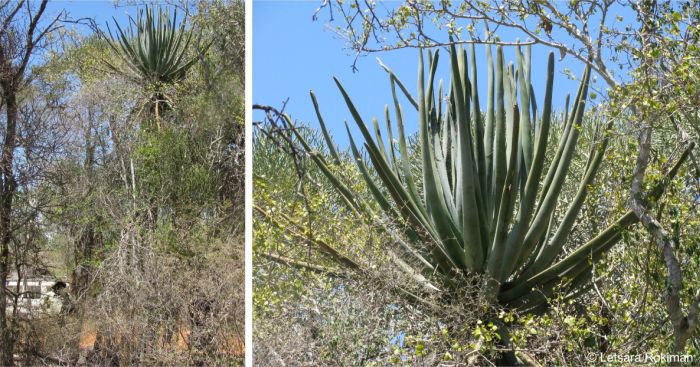
Description
Description
Aloestrela suzannae is a solitary, single-stemmed, large perennial that can grow very tall, reaching heights of about 4 m tall with a trunk about 250 mm in diameter. The leaves are typically lanceolate, curved upwards, exhibiting a rich green colour with subtle bluish, pinkish and grey tones, the surface is rough to the touch, lacking spots and scattered prickles, the margins with small triangular teeth, and the tips of the leaves blunt and rounded.
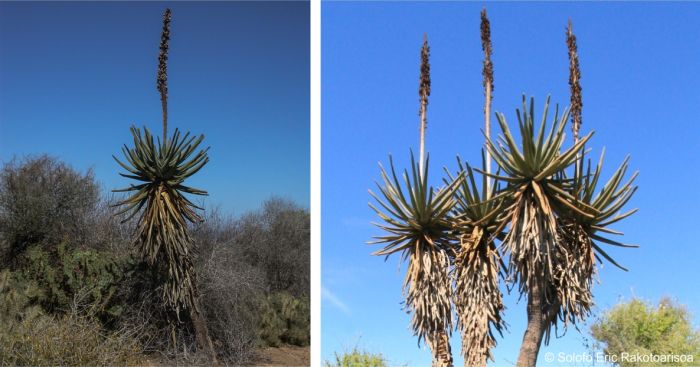
Flowering only occurs on mature plants that are at least 20 to 30 years old, in late winter and spring, and they don’t produce an inflorescence every year, only every 3 to 5 years. During its flowering period, the plant produces a huge, upright, unbranched inflorescence about 3 m long, densely covered with masses of fragrant, delicate, tubular flowers, white to ivory and flushed with orange-pink, with yellow stamens protruding beyond the mouth of the flower. The fruit is a capsule, the seeds shortly winged.
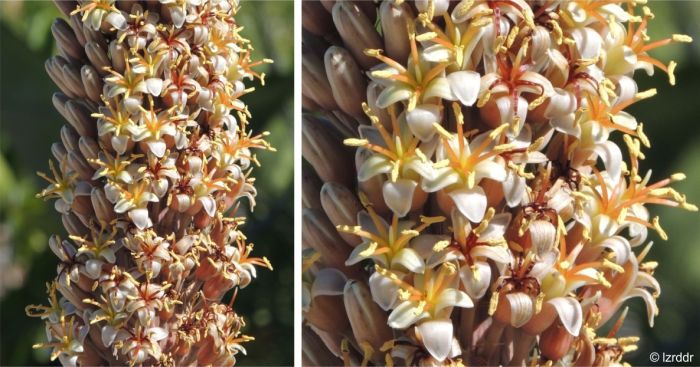
Conservation Status
Status
Currently, Aloestrela suzannae is assessed as Endangered (EN) by the IUCN Red List, in 1998 it was assessed as Critically Endangered (CR). The primary threats are habitat loss and environmental changes, including deforestation caused by clearing of the habitat for crop farming, urbanization, and climate change, which have significantly reduced its natural habitat and its wild population, which continues to decline. Currently the wild population is estimated to be between 400 and 800 mature individuals. Conservation efforts are underway to protect this species, focusing on habitat restoration and awareness campaigns to highlight its ecological importance and rarity. The species occurs within three Protected Areas. Seeds have been banked and living collections are maintained in botanic gardens (ex situ conservation). The species is listed on CITES Appendix 1.
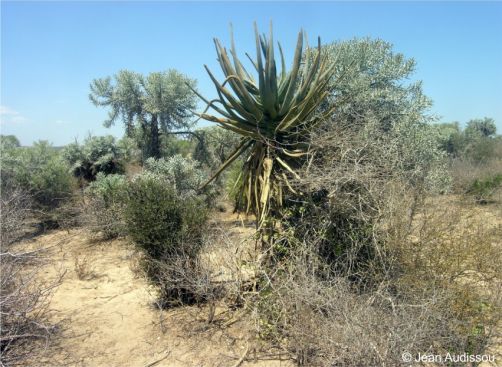
Distribution and habitat
Distribution description
This aloe is endemic to Madagascar, occurring in the dryer south and south-west of the island in the districts of Ampanihy and Taolagnaro and was previously known from Ambovombe-Androy and Amboasary-Sud but it is now thought to be locally extinct in this region. Aloestrela suzannae, thrives in subtropical and tropical climates. It is predominantly found in southwestern coastal bushland on sandy soil and limestone substrate and in dry spiny forest, often among rocks, where it is part of a rich diversity of flora and fauna. The species prefers well-drained soils with adequate moisture, often growing in the shade of other plants that protect it from direct sunlight.
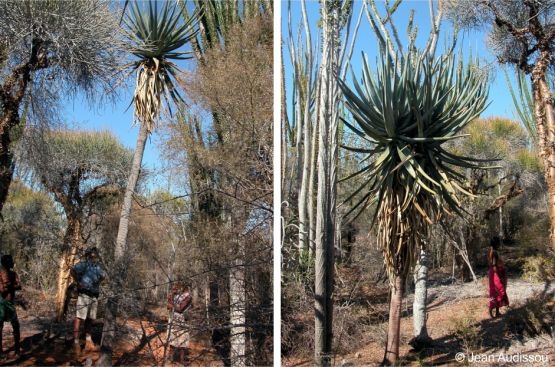
Derivation of name and historical aspects
History
Aloestrela is a genus of flowering plants belonging to the family Asphodelaceae. This genus is named in honour of Professor Dr Estrela Figueiredo of the Department of Botany of the Nelson Mandela University in Gqeberha, South Africa. The specific epithet suzannae honours Suzanne Decary, the daughter of French naturalist and plant collector Raymond Decary (1891-1973) who studied and collected extensively in Madagascar. Decary described this species as Aloe suzannae in 1921. Gideon Smith and Steven Molteno moved this species into the genus Aloestrela in 2019, thus the name Aloe suzannae Decary is a synonym of Aloestrela suzannae (Decary) Molteno & Gideon F.Sm. This revision was necessary because phylogenetic analysis of the genus Aloe revealed that not all the members of the genus shared the same common ancestor. In this case, Aloestrela suzannae was shown to be more closely related to the genus Kumara than Aloe, and their lineage diverged from the Aloe lineage a long time ago. Aloestrela contains just one species, Aloestrela suzannae. Members of the Asphodelaceae encompass a range of flowering plants, including Aloe, Bulbine, Bulbinella, Gasteria, Haworthia, Haworthiopsis and Kniphofia, many of which are celebrated for their ornamental qualities and medicinal properties. Historically, the family has been noted for its ecological roles, contributing to various habitats through their interactions with pollinators and other organisms.
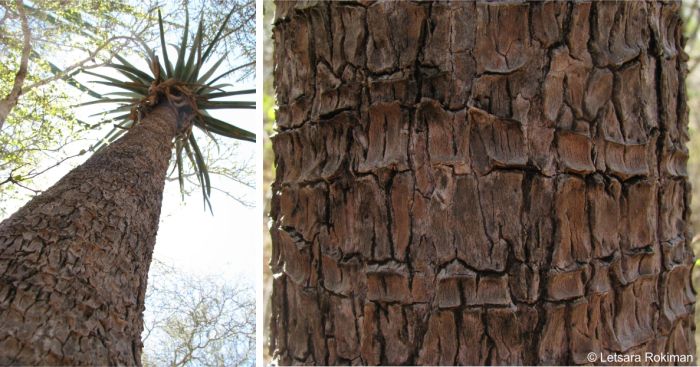
Ecology
Ecology
In its natural habitat, Aloestrela suzannae plays a vital role in maintaining ecological balance. The plant serves as a food source for several insect species, including pollinators such as bees and butterflies, and possibly also for bats, birds and lemurs. Its flowers provide nectar and pollen, and produce seeds, while the foliage offers shelter to various small animals. Additionally, Aloestrela suzannae contributes to soil health through leaf litter decomposition, enriching the nutrient cycle within its ecosystem.
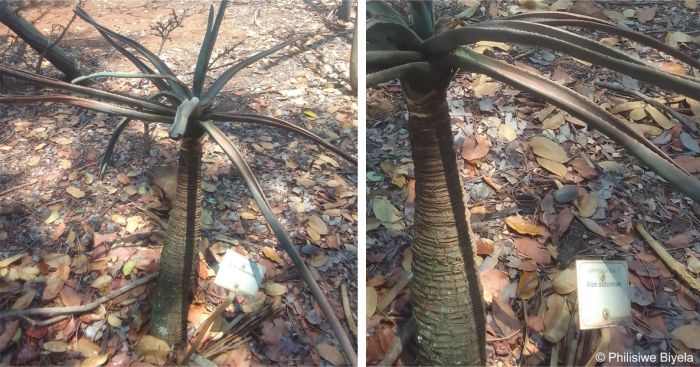
Uses
Use
Aloestrela suzannae makes a striking specimen plant well-suited for xeriscaping, desert gardens and rock gardens. This plant is rare and threatened in its native habitat and is listed on CITES Appendix 1. Only purchase nursery-grown stock from reputable growers, and when trading over an international border, all plant material must have CITES permits. Culturally, Aloestrela suzannae holds significance in local traditions and practices. Indigenous communities often utilize the plant in traditional medicine, employing its leaves and flowers for various therapeutic purposes. Additionally, its aesthetic appeal has led to its inclusion in ornamental gardening, where it is appreciated for both its beauty and ecological benefits.
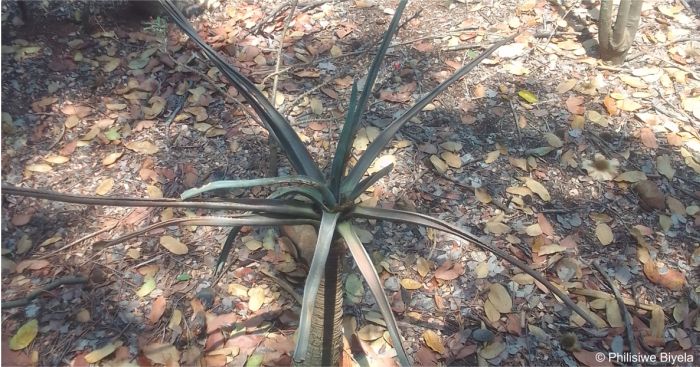
Growing Aloestrela suzannae
Grow
Propagation of Aloestrela suzannae is almost exclusively by seeds, planted in spring or early summer, in trays of coarse river sand. When growing this species, it is essential to mimic its natural habitat. This includes providing well-drained, nutrient-rich soil and ensuring adequate moisture without waterlogging. Shade and good ventilation are crucial, and while it prefers a sunny situation, direct sunlight can hinder the growth of young plants. In its habitat young plants often grow in the shade of larger shrubs and trees, but with age they grow up into the sunlight. Regular monitoring and care will help ensure a healthy plant, contributing to both private gardens and conservation efforts.
Aloestrela suzannae is an adaptable, low-maintenance plant. It is best suited to dry tropical to subtropical or temperate climates with mild, frost-free winters and hot summers, and not too much rain, but will tolerate mild frost. Grow in well-drained, sandy or sandy loam soil, in sun, semi-shade or dappled shade.
In cold or wet climates, it can be grown in large containers and placed where conditions can be controlled. Always use a good quality, sandy loam soil with plenty of drainage chips at the bottom of the container. It tolerates weekly watering in the summer but should be watered once a month, or not at all in the colder winter months. It will grow much better if moved outdoors in spring and summer.
Aloestrela suzannae can tolerate long periods of drought, but they will thrive and flower more often if watered moderately but regularly during spring and summer. Too much watering, poor drainage or too much shade can lead to rotting and attacks by pests and diseases. They grow slowly but can be somewhat faster in cultivation, increasing their height by 5-10 cm per year under favourable conditions.
References
- Audissou, J.2005-Sep. Observation of Aloestrela suzannae, Atsimo-Andrefana region, Madagascar. iNaturalist. Online. https://www.inaturalist.org/observations/203239463.
- Cactus Art Nursery. Aloe suzannae. https://www.cactus-art.biz/schede/ALOE/Aloe_suzannae/Aloe_susannae/Aloe_suzannae.htm. Accessed 21 Oct 2024.
- CITES. Appendices I, II and III, valid from 25 May 2024. https://cites.org/sites/default/files/eng/app/2024/E-Appendices-2024-05-25.pdf.
- Coates Palgrave, K. 2002. Trees of southern Africa. Struik, Cape Town.
- Dee, R., Malakasi, P., Rakotoarisoa, S.E. & Grace, O.M. 2018. A phylogenetic analysis of the genus Aloe (Asphodelaceae) in Madagascar and the Mascarene Islands. Botanical Journal of the Linnean Society 187:428-440.
- Grace, O.M., Klopper, R., Smith, G.F., Crouch, N.R., Figueiredo, E., RØnsted, N.E. & Van Wyk, A.E. 2013. A revised generic classification for Aloe (Xanthorrhoeaceae subfam. Asphodeloideae). Phytotaxa 76(1):7–14.
- Llifle The Encyclopedia of Succulents. Aloe suzannae Decary. http://www.llifle.com/Encyclopedia/SUCCULENTS/Family/Aloaceae/709/Aloe_suzannae. Accessed 21 Oct 2024.
- lzrddr. 2019-Oct. Observation of Aloestrela suzannae, San Diego, USA. iNaturalist. Online. https://www.inaturalist.org/observations/34617517.
- Malagasy Encylopedic Dictionary. Aloe. https://malagasyword.org/bins/teny2/Aloe. Accessed 21 Oct 2024.
- Nichols, G. 2001. A great sculptural species. Farmers Weekly 29 June:87.
- Rakotoarisoa, S.E. 2004-Apr. Observation of Aloestrela suzannae, Atsimo-Andrefana region, Madagascar. iNaturalist. Online. https://www.inaturalist.org/observations/7977519.
- Rakotoarisoa, S.E. 2016. Aloe suzannae. The IUCN Red List of Threatened Species. https://dx.doi.org/10.2305/IUCN.UK.2016-3.RLTS.T39057A67039967.en. Accessed 21 Oct 2024.
- Rikke’s Plants. Aloe suzannae growing and flowering in Copenhagen Botanical Garden. https://bihrmann.com/rikke/subs/alo-suz-sub.asp. Accessed 21 Oct 2024.
- Rokiman, L. 2008-Dec. Observation of Aloestrela suzannae, Anosy region, Madagascar. iNaturalist. Online. https://www.inaturalist.org/observations/1705034.
- Smith, G.F. & Molteno, S. 2019, Aloestrela Molteno & Gideon F.Sm. (Asphodelaceae: Alooideae), a new alooid genus with A. suzannae (Decary) Molteno & Gideon F.Sm. as the only species. Bradleya 37:3-7.
Credits
Philisiwe Biyela, Pretoria National Botanical Garden
and Alice Notten, Kirstenbosch National Botanical Garden
November 2024
Acknowlegements: the authors thank Solofo Eric Rakotoarisoa, lzrddr, Letsara Rokiman and Jean Audissou for making their images of Aloestrela suzannae available via iNaturalist.
Plant Attributes:
Plant Type: Succulent, Tree
SA Distribution:
Soil type: Sandy, Loam
Flowering season: Spring, Winter
PH:
Flower colour: White, Cream
Aspect: Full Sun, Morning Sun (Semi Shade), Afternoon Sun (Semi Shade)
Gardening skill: Challenging
Special Features:
Horticultural zones










Rate this article
Article well written and informative
Rate this plant
Is this an interesting plant?
Login to add your Comment
Back to topNot registered yet? Click here to register.